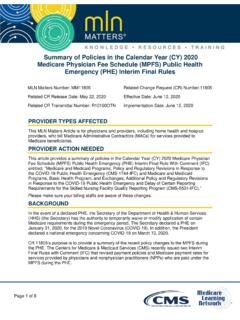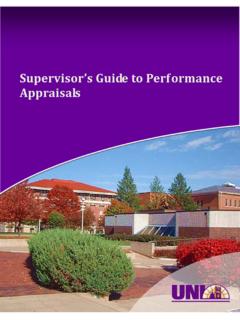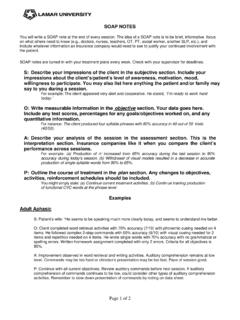Transcription of Overview of the Patient-Driven Groupings Model (PDGM)
1 Overview of the Patient-Driven Groupings Model (PDGM) February 12, 2019 Presenters: Kelly Vontran, Technical Advisor, Division of Home Health and Hospice Wil Gehne, Technical Advisor, Division of Institutional Claims Processing 2 Acronyms in this Presentation BLS: Bureau of Labor Statistics CPM + NRS: Cost per Minute + Non-RoutineSupplies CY: Calendar Year HH PPS: Home Health Prospective Payment System HH: Home Health HHAs: Home Health Agencies HHRGs: Home Health Resource Groups HIPPS: Health Insurance Prospective PaymentSystem ICD: International Classification of Diseases IV: Intravenous LUPA: Low Utilization Payment Adjustment MedPAC: Medicare Payment Advisory Commission MMTA: Medication Management, Teaching, andAssessment MS: Musculoskeletal MSS: Medical Social Services OASIS: Outcome and Assessment Information Set O T: Occupational Therapy PDGM: Patient-Driven Groupings Model PT: Physical Therapy RAP: Request for Anticipated Payment SLP: speech Language Pathology SN: Skilled Nursing WWMC.
2 Wage Weighted Minutes of Care3 Agenda HH PPS** of the PDGM Period Costs Periods Source and Timing Groups Impairment Levels Group Weights Adjustments Tool and Example Scenarios Changes ** indicates section to follow 4 Current Home Health Prospective Payment System (HH PPS) Implemented in October 2000 Bundled payment for all covered HH services provided in a 60-day episode Level of payment determined by case-mix adjustment Allows different payment for patients with different needs Differential resource use intensity measured using wage-weighted minutes of care (WWMC) Amount of time multiplied by average wages from the Bureau of Labor Statistics (BLS) by home health discipline 5 Current Home Health Prospective Payment System, continued Home Health Agencies (HHAs) complete the Outcome and Assessment Information Set (OASIS) for each patient Result of the assessment groups episode into one of 153 Home Health Resource Groups (HHRGs) Timing (early/late episodes.)
3 Exception 20+ therapy group) 3 clinical levels 3 functional levels 9 service use categories (number of therapy visits) HHRG is the starting point for payment calculation 6 Current Home Health Prospective Payment System, continued 153 Home Health Resource Groups (HHRGs) based on severity levels: Clinical: whether the patient has one or more clinical conditions such as incontinence; intravenous infusion (IV), enteral, or parenteral therapies; the presence of wounds or pressure ulcers, etc. Functional: whether the patient has problems with activities of daily living such as dressing, bathing, transferring, walking (locomotion), and toileting Service utilization: based on the number of therapy visits during the episode Source: MedPAC Payment Basics as of 10/14/16.
4 Available at: 7 Motivation for Development of the PDGM Section 3131(d) Report to Congress Section 3131(d) of the Affordable Care Act - Report to Congress found current payment system produced lower margins for those patients : needing parenteral nutrition with traumatic wounds or ulcers who required substantial assistance in bathing admitted to HH following an acute or post-acute stay who have a high Hierarchical Condition Category score who had certain poorly controlled clinical conditions who were dual eligible Source: 8 Motivation for Development of the PDGM MedPAC Annual Reports (2011, 2015, 2017) The Medicare HH benefit is ill-defined HH payment should not be based on the number of therapy visits Payments based on therapy thresholds creates financial incentives that distract agencies from focusing on patient characteristics when setting plans of care.
5 Trend of notable shifts away from non-therapy visits. HH payment should be determined by patient characteristics Source: pdf?sfvrsn=0 9 Development of the PDGM Reexamined payment reform principles Improve payment accuracy for HH services Promote fair compensation to HHAs Increase the quality of care for beneficiaries Conducted initial analytic work Assessing utilization of current payment system Considered alternative approaches to construct case-mix weights Diagnosis on top Predicted therapy Home Health Groupings Model Payment reform solidified by Bipartisan Budget Act of 2018 Payment based on 30-day periods (instead of 60-day episodes)
6 Elimination of therapy thresholds 10 Agenda HH PPS of the PDGM** Period Costs Periods Source and Timing Groups Impairment Levels Group Weights Adjustments Tool and Example Scenarios Changes ** indicates section to follow 11 Patient-Driven Groupings Model (PDGM) The PDGM is a new payment Model for the Home Health Prospective Payment System (HH PPS) that relies more heavily on clinical characteristics and other patient information to place home health periods of care into meaningful payment categories and eliminates the use of therapy service thresholds. PDGM will take effect January 1, 2020. In conjunction with the implementation of the PDGM there will be a change in the unit of home health payment from a 60-day episode to a 30-day period.
7 12 How the Patient-Driven Groupings Model Works Five main case-mix variables Source grouping Impairment Level Adjustment A 30-day period is grouped into one subcategory in each color category This results in 432 possible case-mix adjusted payment groups into which a 30-day period can be placed: (2*2*12*3*3 = 432 HHRGs) 1 Gastrointestinal tract/Genitourinary system 2 The infectious disease category also includes diagnoses related to neoplasms and blood-forming diseases 13 Agenda HH PPS of the PDGM Period Costs** Periods Source and Timing Groups Impairment Levels Group Weights Adjustments Tool and Example Scenarios Changes ** indicates section to follow 14 Measuring 30-Day Period Costs Under PDGM Need to measure period costs to calculate case-mix adjustment factors that account for variation in costs among different units of services.
8 Cost per Minute plus Non-Routine Supplies (CPM + NRS) Approach Uses Medicare cost reports and better reflects total HHA costs Incorporates NRS into the base payment instead of requiring a separate Model (as is done under the current payment system) 15 Cost per Minute plus Non-Routine Supplies (CPM + NRS) Data Sources Cost reports, HH Medicare claims General Approach Total costs multiplied by amount of care provided for each discipline Costs Represented Wages, fringe benefits, overhead costs, transportation costs, other non-visiting services labor costs Non-Routine Supply Use NRS cost-to-charge ratio to obtain NRS costs per period 16 Agenda HH PPS of the PDGM Period Costs Periods** Source and Timing Groups Impairment Levels Group Weights Adjustments Tool and Example Scenarios Changes ** indicates section to follow 17 30-Day Periods In the current HH PPS, HHAs are paid for each (up to)
9 60-day episode of care provided. However, more visits tend to occur in the first 30-day period of a 60-day episode of care. For the PDGM, payment is made for each 30-day period, as required by the BBA of 2018. Only affects payment, no changes to the requirements for certification/recertification, completion of OASIS assessments, or updates to the patient s plan of care, all of which continue to be done on a 60-day basis. 18 National, Standardized 30-day Period Payment Amount The PDGM will not be implemented until CY 2020. However, to provide HHAs with a sense of the payment amount for a 30-day period of care, we estimated that if the PDGM was implemented in CY 2019, the estimated national, standardized 30-day payment would be: $1, This 30-day payment amount will be updated for CY 2020.
10 19 Agenda HH PPS of the PDGM Period Costs Periods Source and Timing** Groups Impairment Levels Group Weights Adjustments Tool and Example Scenarios Changes ** indicates section to follow 20 Periods are Grouped by Admission Source and Timing Admission source Institutional versus community Period timing Early versus late 21 Admission Source Institutional: Acute (inpatient acute care hospitals), or; Post-acute (skilled nursing facility, inpatient rehabilitation facility, long term care hospital, or inpatient psychiatric facility) care in the 14 days prior to the HH admission Community: No acute or post-acute care in the 14 days prior to the HH admission 30-day periods with an institutional admission source were found to have higher resource use than periods with a community admission source 22 Timing Sequence of HH periods: Periods with no more than 60 days between the end of one period and the start of the next period (no change from current definition) Early periods.















